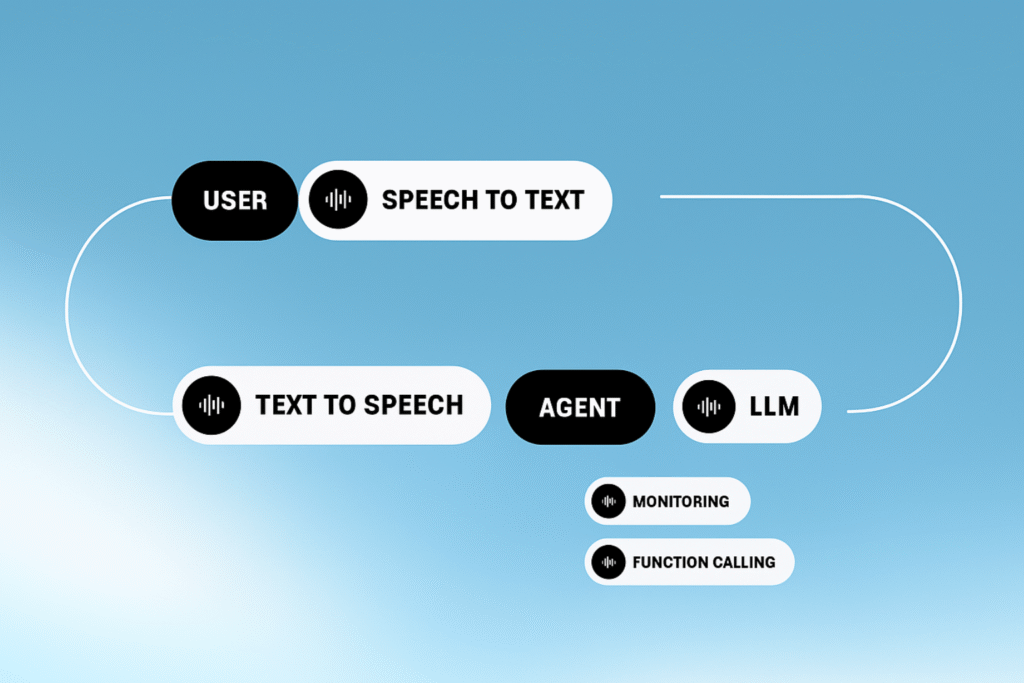We are living in an era where texts, images and videos can now be created by artificial intelligence. But there is one element that is gaining strength as a competitive advantage: the voice.
Whether in podcasts, institutional videos, tutorials or even automated service, the ability to create realistic artificial voice is changing how companies and creators communicate. And in this scenario, the ElevenLabs AI emerges as one of the global protagonists.

What is ElevenLabs?
O ElevenLabs is one of the neural speech synthesizers most advanced on the market. With its technology AI voice cloning and AI-powered text to speech, allows you to create realistic voices in multiple languages, with natural intonation, dynamic pauses and surprising emotional nuances.
Key Features:
- Human-quality Text to Speech
- Conversational AI with support for interactive agents
- Studio for longform audio editing
- Speech to Text with high accuracy
- Voice Cloning (Instant or Professional)
- Sound Effects Generation (Text to Sound Effects)
- Voice Design and Noise Isolation
- Voice Library
- Automatic dubbing in 29 languages
- Robust API for automations with tools like N8N, Make, Zapier and custom integrations

ElevenLabs FAQ
Find out more about the company and news from ElevenLabs directly at official website of ElevenLabs and see the API documentation.
Does ElevenLabs have an API?
Yes, ElevenLabs has a complete API that allows you to integrate speech generation with automated workflows.
With this, it is possible to create applications, service bots, or content tools with automated audio.
Discover the Make Course from NoCode Start Up to learn how to connect the ElevenLabs API with other tools.
Are ElevenLabs voices copyright free?
AI-generated voices can be used commercially, as long as you respect the platform's Terms of Use and do not violate third-party rights by cloning real voices without authorization.
Is it possible to use ElevenLabs for free?
Yes. ElevenLabs offers a free plan with 10,000 credits per month, which can be used to generate up to 10 minutes of premium quality audio or 15 minutes of conversation
This plan includes access to features like Text to Speech, Speech to Text, Studio, Automated Dubbing, API, and even Conversational AI with interactive agents.
Ideal for those who want to test the platform before investing in paid plans.
What is the best alternative to ElevenLabs?
Other options include Descript, Murf.ai and Play.ht. However, ElevenLabs has stood out for its natural voice, advanced audio editing features with AI, API integration and support for multiple languages.
Their paid plans start from US$ 5/month (Starter) with 30 thousand monthly credits, and go up to scalable corporate versions with multiple users and millions of credits.
See all available plans on the ElevenLabs website. However, ElevenLabs has stood out for the naturalness of its voice and the quality of its API.
How does ElevenLabs work?
You submit a text, choose a voice (or clone one), and AI converts that text into realistic audio in seconds. It can be used via the web dashboard or via API for automated workflows.
Examples of using ElevenLabs AI in practice
1. Video and podcast narration
Ideal for creators who want to save time or avoid the costs of professional voiceovers.
2. Automated service with human voice
Turn cold bots into realistic, empathetic voice assistants.
3. Generating tutorials and training with audio
Companies and CLT professionals can create more engaging internal materials.
4. Applications that “talk” to the user
With tools like Bubble, FlutterFlow or WebWeb, it is possible to integrate AI voice into apps.
How to integrate ElevenLabs with NoCode tools

N8N + ElevenLabs API
Allows you to automate voice generation based on dynamic data using visual workflows in N8N. It is ideal for creating processes such as audio customer service responses, automated voice updates, and more.
Discover the N8N Course from NoCode Start Up
OpenAI Agents + ElevenLabs
With the use of AI agents, it is possible to create voice-responsive systems, such as a virtual attendant that speaks to the customer based on a dynamic prompt.
See the Agents with OpenAI Course
Bubble/FlutterFlow + ElevenLabs
Use the API to insert audio into your apps with interaction triggers or dynamic events.
ElevenLabs and NoCode: Open the door to creating experiences with voice AI
AI-generated voice is already a powerful, accessible and potential-rich reality. ElevenLabs is not just a tool, but an engine for creating immersive, automated and more human experiences.
If you want to learn how to integrate these possibilities with NoCode and AI tools, NoCode Start Up has the ideal paths:










